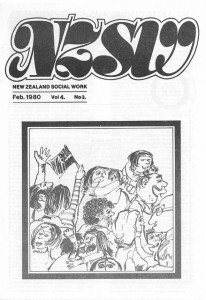As contributors to the C50 panel discussion on the second decade of the ANZASW have highlighted this was a time (from 1974 to 1983) of growing social consciousness, social action and the emergence of countercultural movements such as the anti-psychiatry movement and the human potential movement.

The cover of February 1980 copy of New Zealand Social Work offered an illustration to accompany an article on sensitivity groups in social work, and the C50 panel discussion refers to the involvement of social workers in sensitivity training and encounter groups.
At the same time feminism, anti-racism and debates about trade unionism were all evident in the work of the association. During the country wide protests against the tour of the South African rugby team in 1981 an association news supplement included the following anti-Springbok tour statement:
The NZASW abhors the presence of the representatives of the oppressive anti-apartheid system, namely the Springbok rugby team in NZ.
The NZASW supported peaceful protests, and condemned police behaviour. A recent article by Jackie Sayers (2014) reflects on anti-racism training in Aotearoa New Zealand in the 1980s and highlights the active role of many social workers in resisting the Springbok tour.
The Springbok Tour of 1981 divided and rallied New Zealand around the causes of South Africa. Social workers around the country were heavily involved in the protests and I remember that in our city marches were held every Wednesday and Saturday throughout the entire period of the games – three months, I think. Staff from the Department of Social Welfare, including myself, marched around the city streets in their lunch breaks to be booed at by rugby supporters. A call had been made by the anti-tour movement for people to wear black armbands, as if in mourning. So I wore one to work, only to be hauled before the boss for inappropriate dress for a government employee. Fair enough. I subsequently dressed entirely in black for the remainder of the tour. Not much of a protest, but it was the best I could do at the time. (p. 83)
The 1982 biennial conference was held in Auckland on the theme of Social Justice: a Social Work Concern for the 80s and the conference included themes on unemployment (which was on the increase); health; housing; race and poverty.
In 1983 the Association took a strong stance against statements made by Prime Minister Robert Muldoon to the Rotary in Palmerston North where he “blamed parents for the anti-social behaviour of young people” (NZASW, 1983). The association issued a press release drawing attention to a recently published Report of the Advisory Committee on Youth and the Law in our Multicultural Society (Tauroa, 1983) and argued that:
Families in distress need a greater level of community support and understanding rather than a ‘blame the victim’ approach.
Make a comment
If you were involved in any of these campaigns why not post a comment on your reflections below?
Access the resources
Download a copy of:
The 1983 NZASW press release on young people and the law.
References
Sayers, J. (2014). Reminiscences of anti-racism training in the 1980s. Aotearoa New Zealand Social Work Review, 26(26), 81–85. Retrieved from http://anzasw.nz/wp-content/uploads/Social-Work-Review-Volume-26-Numbers-2-and-3-2014-Reflections-Jackie-Sayers.pdf
Tauroa, H. (1983). Report of the Advisory Committee on Youth and the Law in our Multicultural Society. Wellington: Department of Social Welfare.






